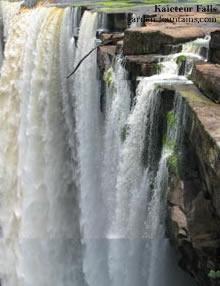 The Kaieteur Falls are the iconic picture of jungle waterfalls! It is fed by the Potaro river, and is 370 feet wide and falls 741 feet over the Guiana Shield, hitting a few cascades on the way down, which increase the height of the waterfall to 822 feet. Interesting, the Guiana shield is actually thought to be the worlds oldest surface above the ocean. It is roughly 2 billion years old, and has managed to stay above the water or from being pulled under the earth’s crust during periods of volcanic activity. This shield is a tepuis, or a tabletop mountain, one of many in South America. Basically it is a jungle covered plateau.
The Kaieteur Falls are the iconic picture of jungle waterfalls! It is fed by the Potaro river, and is 370 feet wide and falls 741 feet over the Guiana Shield, hitting a few cascades on the way down, which increase the height of the waterfall to 822 feet. Interesting, the Guiana shield is actually thought to be the worlds oldest surface above the ocean. It is roughly 2 billion years old, and has managed to stay above the water or from being pulled under the earth’s crust during periods of volcanic activity. This shield is a tepuis, or a tabletop mountain, one of many in South America. Basically it is a jungle covered plateau.
The Kaieteur Falls was an easy decision when it comes to preservation. Existing in one of the most diverse rain forests of the world, the location of the falls is virtually untouched by human habitation, making it easy to protect!
Located in the north eastern portion of South America, at Mazaruni-Potaro, on the Kaieteur gorge. There are many ways to visit the falls. Visitors can take a three day guided trek to reach the base of the falls, which give the hiker many opportunities to view the falls from different angles. You could also go by air, and reach the falls in about an hour.
There is a legend tied to that falls, it states that a chief of the Patamona tribe, named Kai, sacrificed his life by falling over the falls. He wanted to appease the Great Spirit, Makonaima, so he would intervene and keep his tribe from being raided by the Carib tribe. This is where the falls gets the name kaieteur, with teur meaning falls. So the falls actual name is Kai falls Falls.
Kaieteur National park features a wide array of different plant species, with about 35% of them being endemic. This area is one of the most lush and vibrant rain forests in the world. Several endangered species also call the national park home, for example the Makonaima bird, which nest amongst the cliffs of the waterfall. The Golden Frog also calls this area home, he is adorned with bright vibrant colors that excrete poison. The plumage of the Cock-of-the-Rock bird can also be seen here, with its bright orange coloration.
